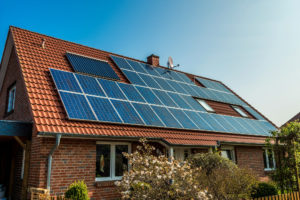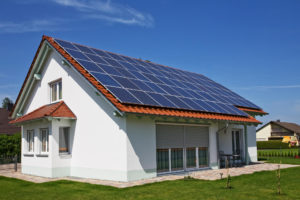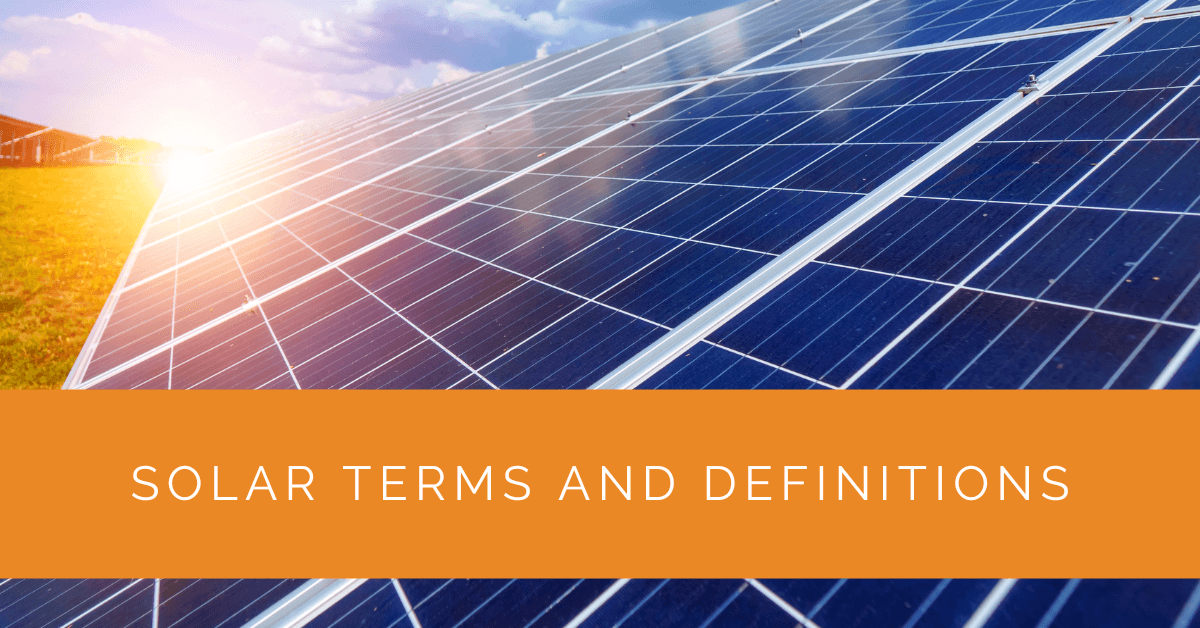Understanding the terminology used in the solar industry is crucial for anyone interested in solar energy. This guide will delve into the solar terms and definitions you need to know to navigate the world of solar power effectively.
Contents
Solar Energy Basics
Solar energy is a clean, abundant, and renewable power source with great potential for meeting our energy needs. Understanding the fundamental concepts related to solar energy is essential for grasping the workings of solar power systems and the benefits they offer.
Solar Energy
Solar energy is radiant light and heat from the sun that can be converted into usable forms of energy. It is harnessed through solar panels, which capture sunlight and convert it into electricity or heat through the photovoltaic (PV) effect.
Solar Panel
A solar panel, also known as a photovoltaic (PV) module, is a device composed of solar cells that convert sunlight directly into electricity. The solar cells within the panel are made of semiconductor materials, such as silicon, which generate an electric current when exposed to sunlight.
Solar Cell
A solar cell is the basic unit of a solar panel that converts sunlight into electricity. It is typically a wafer-thin semiconductor device made of silicon or other materials. When photons from sunlight strike the solar cell, they dislodge electrons, creating a flow of electricity known as a direct current (DC).
Solar Array
A solar array refers to a collection of interconnected solar panels that work together to generate electricity. By combining multiple panels, a solar array can produce more power to meet the energy needs of homes, businesses, or entire communities.
Solar Power System
A solar power system encompasses all the components required to harness solar energy and convert it into usable electricity. It typically includes solar panels, an inverter to convert DC electricity into AC electricity, mounting structures to secure the panels, and wiring to connect the system.
Solar Inverter
A solar inverter is a vital component of a solar power system. It converts the DC electricity generated by solar panels into AC electricity, the electricity used by most electrical appliances and the power grid. The inverter ensures compatibility between the solar system and the electrical infrastructure.
Grid Connection
Solar power systems can be connected to the electrical grid, allowing for the exchange of electricity between the system and the utility company. Excess electricity generated by the solar system can be fed back into the grid, and when the system produces insufficient power, electricity can be drawn from the grid.
Renewable Energy
Solar energy is a prime example of renewable energy, which refers to energy sources that can be naturally replenished and have minimal environmental impact. Unlike fossil fuels, which deplete finite resources and contribute to pollution, solar energy offers a clean and sustainable alternative.
Solar Thermal Systems
In addition to photovoltaic systems, solar thermal systems can utilize solar energy. These systems capture the sun’s heat to generate thermal energy, often used for water heating, space heating, or industrial processes. Solar thermal systems typically employ collectors to absorb and transfer heat from sunlight.
Understanding these foundational solar energy concepts lays the groundwork for exploring the various applications, benefits, and advancements in solar power technology. By harnessing the sun’s power, we can tap into a virtually limitless source of clean energy and move towards a more sustainable future.

Solar Panel System Components
A solar power system comprises several key components that harness solar energy and convert it into usable electricity. Understanding these components is crucial for designing, installing, and maintaining an efficient and reliable solar power system.
Solar Panels
Solar panels, also known as photovoltaic (PV) modules, are the heart of a solar power system. They consist of interconnected solar cells, typically silicon, which absorb sunlight and convert it into electricity through the photovoltaic effect. The size and number of solar panels determine the overall energy-generating capacity of the system.
Inverter
An inverter is an essential component that converts the direct current (DC) electricity produced by the solar panels into alternating current (AC) electricity, compatible with standard electrical systems in homes and businesses. The inverter ensures that the solar power system can power electrical appliances and feed excess electricity into the grid.
Mounting Structures
Mounting structures provide the necessary support and stability for solar panels. These structures can be rooftops, ground, or pole mounts, depending on the installation location. Properly designed and installed mounting systems ensure solar panels’ optimal tilt and orientation to maximize sunlight exposure.
Wiring and Connectors
Wiring and connectors interconnect solar panels, inverters, and other system components. They form the electrical pathways that carry the generated electricity from the solar panels to the inverter and then to the electrical load or the grid. High-quality wiring and connectors ensure efficient electricity transmission and system reliability.
Racking and Balance of System (BOS) Components
Racking refers to the framework or structure that supports and positions solar panels on rooftops or other mounting surfaces. BOS components encompass all the equipment and materials required for a functional solar power system, such as junction boxes, combiner boxes, circuit breakers, surge protectors, and grounding systems. These components ensure the safe and reliable operation of the solar power system.
Energy Storage System
An energy storage system is an optional component that stores excess electricity generated by the solar panels for later use. It utilizes batteries or other storage technologies to capture and store surplus energy. Energy storage systems allow for increased self-consumption of solar power and provide backup power during grid outages.
Monitoring and Control Systems
Monitoring and control systems provide real-time data on the performance and efficiency of the solar power system. They enable system owners to monitor energy production, track system health, detect issues or malfunctions, and optimize system performance. Monitoring systems often include online portals or mobile apps for convenient access to system data.
Grid Connection and Net Metering
Solar power systems can be connected to the electrical grid, allowing electricity exchange with the utility company. Grid-connected systems enable the export of excess electricity to the grid when the solar panels produce more energy than needed. Net metering arrangements allow system owners to receive credits or compensation for the excess electricity they feed into the grid.
Understanding the various components of a solar power system is crucial for designing and installing a system that meets energy needs efficiently and reliably. Each component is vital in capturing solar energy, converting it into usable electricity, and ensuring seamless integration with the electrical grid or off-grid applications. Proper selection, installation, and maintenance of these components are key to maximizing the benefits of solar power systems.

Solar Energy Terminology and Glossary
To help you navigate the extensive terminology used in the solar industry, we have compiled a comprehensive solar energy glossary. This glossary serves as a valuable reference, providing definitions and explanations of key terms related to solar power systems, energy storage, grid integration, and more. Familiarize yourself with these terms to enhance your understanding of solar energy and communicate effectively within the industry.
- Alternating Current (AC): Electric current that periodically changes direction. AC electricity is the standard form of electricity used in homes and businesses.
- Azimuth: The horizontal direction or compass bearing of a solar panel installation. Azimuth angles are used to optimize solar panel positioning for maximum sunlight exposure.
- Direct Current (DC): Electric current that flows in one direction. Solar panels generate DC electricity, which is converted into AC electricity for use in homes and businesses.
- Grid Tie: A solar power system connected to the utility grid. Grid-tied systems allow for the seamless exchange of electricity between the solar panels and the utility grid, providing power to the property while allowing excess electricity to be fed back into the grid.
- Microinverter: An inverter technology that converts DC electricity into AC electricity at the individual solar panel level. Microinverters offer advantages such as panel-level optimization, improved system performance, and simplified installation.
- Net Metering: A billing arrangement where the excess electricity generated by a solar power system is fed back into the utility grid, and the property owner receives credits for the exported electricity. These credits can be used to offset future electricity consumption from the grid.
- Off-Grid System: A standalone solar power system not connected to the utility grid. Off-grid systems typically incorporate energy storage solutions to provide electricity when solar production is limited or unavailable.
- On-Grid System: A solar power system connected to the utility grid. On-grid designs can draw electricity from the grid when solar production is insufficient and feed excess electricity back into the grid.
- Power Purchase Agreement (PPA): A contractual agreement where a solar energy system is installed on a property, and the property owner purchases the electricity the system generates at a predetermined rate. PPAs allow for immediate cost savings without the need for upfront investment.
- PV System: Abbreviation for photovoltaic system, which refers to the complete setup of solar panels, inverters, and associated equipment that generate electricity from sunlight.
- Solar Battery: A device that stores excess electricity solar panels generate for later use. Solar batteries allow for greater energy independence and can provide backup power during grid outages.
- Solar Efficiency: The measure of how effectively solar panels convert sunlight into usable electricity. Higher-efficiency panels can generate more electricity for a given amount of sunlight.
- Solar Installer: A professional or company specializing in designing, installing, and maintaining solar power systems. Solar installers play a crucial role in ensuring solar panels’ efficient and safe installation.
- Solar Investment Tax Credit (ITC): A federal tax credit that provides a percentage reduction in total tax liability for individuals and businesses that install solar energy systems. The ITC has played a significant role in promoting solar adoption and reducing installation costs.
- Solar PV (Photovoltaic): The technology that converts sunlight into electricity using solar cells. PV systems are commonly used in solar panels to generate electricity.
- Solar Reflectance: The ability of a material or surface to reflect sunlight. High solar reflectance helps reduce heat absorption and keeps solar panels and surrounding structures cooler.
- Solar Shading: The obstruction of sunlight falling on solar panels reduces their energy output. Solar shading can be caused by nearby structures, trees, or other objects that cast shadows on the panels.
- Solar Thermal System: A solar energy system that uses sunlight to generate heat rather than electricity. Solar thermal systems are often used for water heating or space heating purposes.
- Solar Tracking System: A mechanism that adjusts the orientation of solar panels throughout the day to maximize their exposure to sunlight. Solar tracking systems can increase energy production by following the sun’s path.
- Solar Irradiance: The amount of solar radiation received per unit area, usually measured in watts per square meter (W/m²). Solar irradiance is a critical factor in determining the energy output of solar panels.
- String Inverter: An inverter technology that converts DC electricity from multiple solar panels connected in series (or string) into AC electricity. String inverters are commonly used in solar power systems and offer cost-effective solutions for residential and commercial installations.
- Tilt Angle: The angle at which solar panels are inclined relative to the horizontal plane. Tilt angles are adjusted based on location, season, and desired energy output.
- Utility Grid: The interconnected network of power generators, transmission lines, and distribution systems that deliver electricity from power plants to consumers. Solar power systems can be connected to the grid, allowing electricity exchange with the utility company.
This glossary provides an overview of key solar energy terms, but it is by no means exhaustive. The solar industry is continually evolving, and new terms and technologies emerge. Stay curious and continue to expand your solar knowledge to stay abreast of the latest advancements and industry terminology.
Expert Insights From Our Solar Panel Installers About Solar Terms and Definitions
Understanding solar terms is crucial for making informed decisions. For instance, knowing the difference between a microinverter and a string inverter can help optimize your solar power system’s efficiency and reliability.
Senior Solar Installer
Terms like ‘net metering’ and ‘power purchase agreements’ are vital for homeowners to grasp as they can significantly impact the financial benefits of their solar installations.
Lead Solar Engineer
Being familiar with solar terminology, such as ‘PV systems’ and ‘solar efficiency,’ empowers consumers to better communicate their needs and expectations with solar professionals.
Architectural Solar Specialist
Experience Solar Excellence with Us!
Trust in Solar Panels Network USA, where our seasoned experts deliver top-quality solar solutions for homes and businesses nationwide. With a legacy of countless successful installations and a commitment to sustainable energy, we’re your reliable partner in the solar journey. Ready for a brighter, eco-friendly future? Call us now at (855) 427-0058 and harness the power of the sun!
Conclusion
By familiarizing yourself with solar terms and definitions, you’ll better understand solar energy and its various components. This knowledge will enable you to engage in meaningful discussions with solar professionals, make informed decisions about solar installations, and navigate the rapidly evolving solar industry. Keep this comprehensive solar glossary as a valuable resource to expand your solar vocabulary and enhance your solar journey.
Remember, as solar power grows and becomes more accessible, staying informed about solar terms and definitions will empower you to make the most of this clean and renewable energy source. With a solid understanding of solar terminology, you’ll be better equipped to discuss solar energy systems, evaluate proposals, and effectively communicate your solar energy needs and goals.
About the Author
Solar Panels Network USA stands at the forefront of solar energy solutions, driven by a team of seasoned solar engineers and energy consultants. With over decades of experience in delivering high-quality solar installations and maintenance, we are committed to promoting sustainable energy through customer-centric, tailored solutions. Our articles reflect this commitment, crafted collaboratively by experts to provide accurate, up-to-date insights into solar technology, ensuring our readers are well-informed and empowered in their solar energy decisions.

